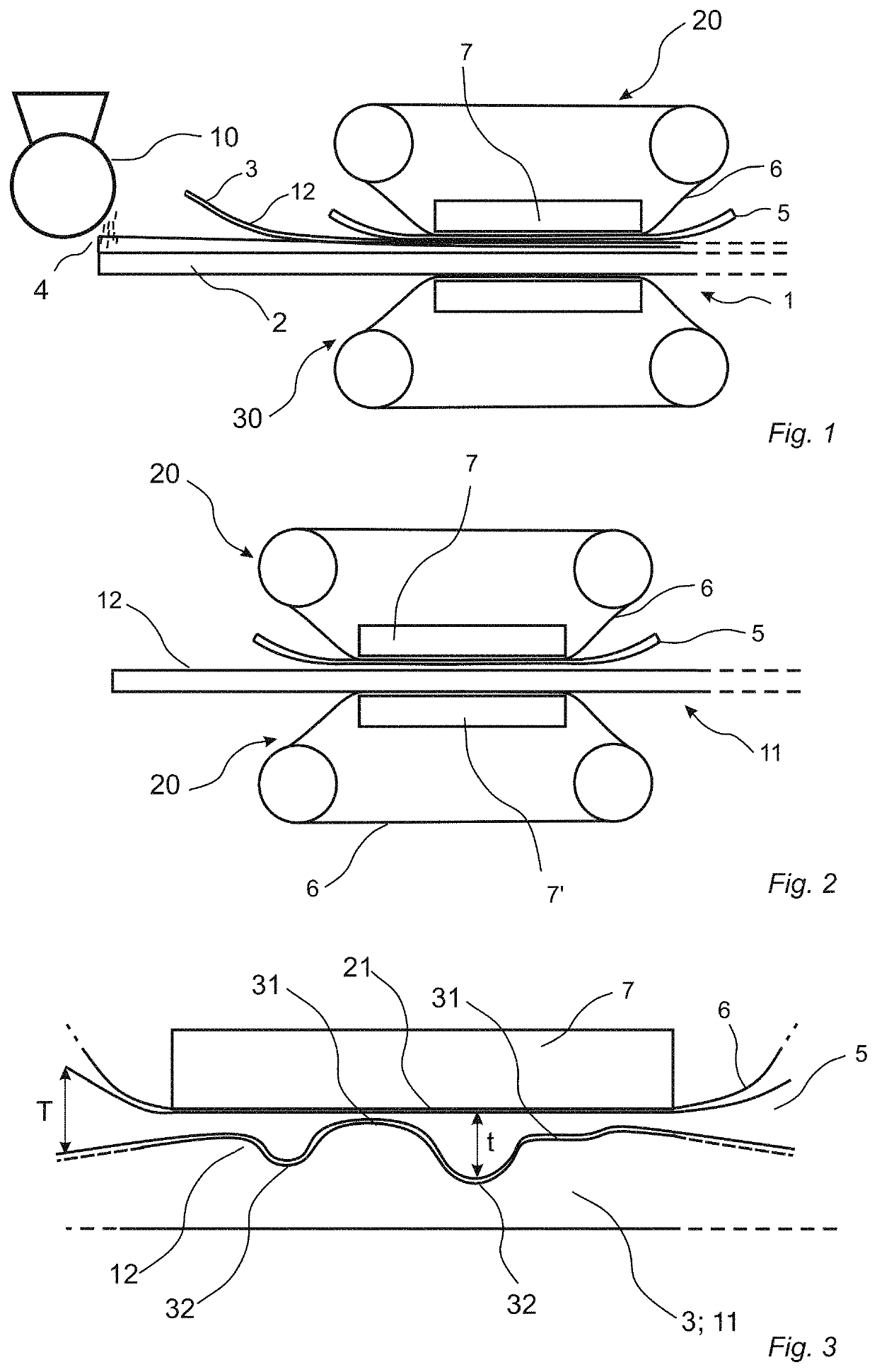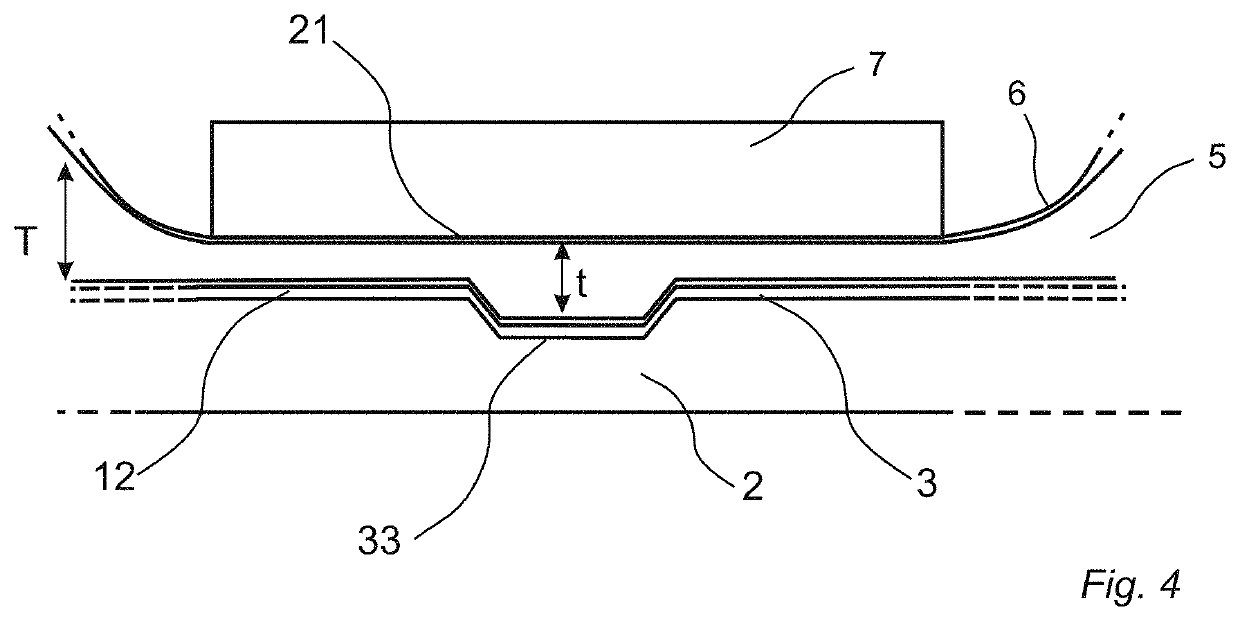Method for producing a building element, a pressing device and a method of embossing a wooden surface
a pressing device and wooden surface technology, applied in the field of building elements, can solve the problems of reducing reducing the vividness and appeal of the visual impression, and uneven distribution of the pressure of the press plate over the surface, so as to reduce the natural structure of the wood veneer layer and increase the natural embossing of the wooden surface.
- Summary
- Abstract
- Description
- Claims
- Application Information
AI Technical Summary
Benefits of technology
Problems solved by technology
Method used
Image
Examples
reference example 1
[0215]A sub-layer comprising a mix in dry form comprising wood fibres in an amount of 37.4 wt %, a binder in form of urea formaldehyde in an amount of 52.5 wt %, pigments and additives, was applied on an HDF board having a thickness of 10 mm. The mix was applied in an amount of 450-500 g / m2. A wood veneer layer having a thickness of 0.6 mm was applied on the sub-layer. The assembly was arranged in a short cycle lamination hot press. The temperature of the upper press table was 195° C. and the temperature of the lower press table was 180° C. The pressure applied was 40 bar. The pressing time was 45 seconds.
[0216]During the pressing, the natural embossing of the wood is flattened out. After pressing, the depth of the embossings was measured to 0-0.1 mm.
example 1
[0217]A sub-layer comprising a mix in dry form comprising wood fibres in an amount of 37.4 wt %, a binder in form of urea formaldehyde in an amount of 52.5 wt %, pigments and additives, was applied on an HDF board having a thickness of 10 mm. The mix was applied in an amount of 450-500 g / m2. A wood veneer layer having a thickness of 0.6 mm was applied on the sub-layer. The assembly was arranged in a short cycle lamination hot press. An elastic sheet in form of a silicone rubber sheet having a thickness of 0.5 mm and a shore value of 40 A as measured according to ISO 868: 2003 was arranged in the press between the wood veneer and the press belt. The temperature of the upper press table was 195° C. and the temperature of the lower press table was 180° C. The pressure applied was 40 bar. The pressing time was 45 seconds.
[0218]During the pressing, the elastic sheet is pressed into the natural embossed structure of the wood veneer layer and increases the depth of the embossed structure. ...
example 2
[0219]A sub-layer comprising a mix in dry form comprising wood fibres in an amount of 37.4 wt %, a binder in form of urea formaldehyde in an amount of 52.5 wt %, pigments and additives, was applied on an HDF board having a thickness of 10 mm. The mix was applied in an amount of 450-500 g / m2. A wood veneer layer having a thickness of 0.6 mm was applied on the sub-layer. The assembly was arranged in a short cycle lamination hot press. An elastic sheet in form of a silicone rubber sheet having a thickness of 0.5 mm and a shore value of 60 A as measured according to ISO 868: 2003 was arranged in the press between the wood veneer and the press belt. The temperature of the upper press table was 195° C. and the temperature of the lower press table was 180° C. The pressure applied was 40 bar. The pressing time was 45 seconds.
[0220]During the pressing, the elastic sheet is pressed into the natural embossed structure of the wood veneer layer and increases the depth of the embossed structure. ...
PUM
| Property | Measurement | Unit |
|---|---|---|
| Temperature | aaaaa | aaaaa |
| Temperature | aaaaa | aaaaa |
| Time | aaaaa | aaaaa |
Abstract
Description
Claims
Application Information
 Login to View More
Login to View More - R&D
- Intellectual Property
- Life Sciences
- Materials
- Tech Scout
- Unparalleled Data Quality
- Higher Quality Content
- 60% Fewer Hallucinations
Browse by: Latest US Patents, China's latest patents, Technical Efficacy Thesaurus, Application Domain, Technology Topic, Popular Technical Reports.
© 2025 PatSnap. All rights reserved.Legal|Privacy policy|Modern Slavery Act Transparency Statement|Sitemap|About US| Contact US: help@patsnap.com


